Kenneth L. Gentry Jr.'s Blog, page 4
June 10, 2025
WAS EVIL KING MANASSEH SAVED?
PMW 2025-041 by Kenneth L. Gentry, Jr.
On this blog site I define postmillennialism as follows:
Postmillennialism holds that the Lord Jesus Christ established his kingdom on earth in the first century through his preaching and redemptive work. Since then he has continued to equip his Church with the gospel, empower her by his Spirit, and charge her with the Great Commission to disciple all nations. Postmillennialism expects that eventually the vast majority of men living will be saved. Increasing gospel success will gradually produce a time in history prior to Christ’s return in which faith, righteousness, peace, and prosperity will prevail in the affairs of men and of nations. After an extensive era of such conditions, the Lord will return visibly, bodily, and gloriously, to end history. Associated with his return will be the general resurrection and the final judgment after which the eternal order follows. Because of its worldwide historical implications, postmillennialism generates an holistic worldview touching on all areas of life.
That being the case, we must be alert to an important distinction between true and false conversions. Postmillennialists are glad for the general influence of Christianity on the world. But what we labor for and ultimately expect is a dramatic impact on the world that is rooted in true conversions by the gospel which is the power of God unto salvation (Rom. 1:16). We are all aware that much of Christianity is today made up of falsely-professing “believers.” These people should be targets of our evangelistic outreach, for being “almost persuaded” is not enough.
We can even examples of false conversions in Scripture. These should forewarn us of the danger of false conversions so as to forearm us to confront them. One classic example is evil King Manasseh.
The picture of Manasseh that we see in 2 Kings is wholly negative. For example, we read: 21:11 “Manasseh king of Judah has done these abominations, having done wickedly more than all the Amorites did who were before him, and has also made Judah sin with his idols” (2 Kgs. 21:11; cp. vv. 9, 16, 17). However, the 2 Chronicles report is distinct in its ending on a positive note suggesting his repentance and conversion.
In 2 Chronicles we read that he “entreated the LORD” and “humbled himself greatly” before God (2 Chron. 33:12). And that he also “prayed to” God who “heard his supplication” then brought him out of captivity, with the result that he “knew the LORD was God” (v. 13). This is followed by his removing idols from the temple (v. 15) and setting up an altar to God and offering peace and thank offerings on it, while ordering his people to “serve the LORD” (v. 16). Then the concluding summary of his life highlights “his prayer to his God” (v. 18), noting how “God was entreated by him” when he “humbled himself” (v. 19).
Conservative scholars are divided as to whether or not Manasseh truly repents. However, I believe the evidence suggests that his “conversion” is superficial at best, not being deeply-rooted and genuine. In fact, it appears to be prompted solely by his emotional “distress” while in captivity (2 Chron. 33:12). As a result, it produces only partial, temporary results. The negative evidence against his conversion includes the following.
First, the writer of Kings does not mention it, though it would be a remarkable example of God’s covenant faithfulness and mercy. And if Manasseh’s conversion were real, it would afford an opportunity for the writer to commend him. For the historian frequently highlights good kings who did “right” in God’s eyes (1 Kgs. 15:5; 22:43; 2 Kgs. 10:30; 12:2; 14:3; 15:3, 34; 18:3; 22:2). Yet, no evaluative commendation of Manasseh appears in the biblical text.
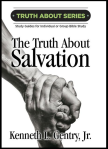 The Truth about Salvation By Ken Gentry
The Truth about Salvation By Ken Gentry
A study guide for personal or small group Bible study. Deals with the Christian doctrine of salvation from a Reformed theological perspective. It opens with a study of God as loving Creator, the shows how the first man fell into sin. Shows God’s righteousness requires that sin be dealt with. Presents Jesus as both God and man so that he can be man’s Savior. Includes review questions and questions for further study.Twelve chapters are ideal for one quarter of Sunday School.
See more study materials at: www.KennethGentry.com
Second, immediately after the report of Manasseh’s supposed “conversion” (2 Chron. 33:12–18), he is used as an evil standard by which his own son is denounced (2 Chron. 33:22). It would be odd for someone to be praised as a devout follower of God in one breath then used as an example a great evil in the next — if he were truly converted.
Third, Manasseh remains a standard of evil that is used to evaluate bad kings:
“He did evil in the sight of the LORD, as Manasseh his father had done” (2 Kgs. 21:20; 2 Chron. 33:22).
“The LORD did not turn from the fierceness of His great wrath with which His anger burned against Judah, because of all the provocations with which Manasseh had provoked Him” (2 Kgs. 23:26).
Fourth, despite good king Josiah’s later reforms (2 Kgs. 23:4–25), God’s wrath is not turned from Judah. Thus, we may used 2 Kgs. 23:26–27 once again, but from this additional perspective: “because of all the provocations with which Manasseh had provoked Him” (2 Kgs. 23:26–27).
Fifth, Jeremiah also points to Manasseh as the reason for Judah’s “doom” — despite his supposed conversion. In fact, he says that not even Moses or Samuel could appear before God to effectively plead for Judah, such is the depth of her sin . . . “because of Manasseh”:
“Then the LORD said to me, Even though Moses and Samuel were to stand before Me, My heart would not be with this people; send them away from My presence and let them go! And it shall be that when they say to you, Where should we go? then you are to tell them, Thus says the LORD: Those destined for death, to death; / And those destined for the sword, to the sword; / And those destined for famine, to famine; / And those destined for captivity, to captivity. I will appoint over them four kinds of doom, declares the LORD: the sword to slay, the dogs to drag off, and the birds of the sky and the beasts of the earth to devour and destroy. I will make them an object of horror among all the kingdoms of the earth because of Manasseh, the son of Hezekiah, the king of Judah, for what he did in Jerusalem.” (Jer. 15:1–4).
Openness Unhindered (by Rosaria Butterfield)
Dr. Butterfield goes to great lengths to clarify some of today’s key controversies. She also traces their history and defines the terms that have become second nature today-even going back to God’s original design for marriage and sexuality as found in the Bible. She cuts to the heart of the problems and points the way to the solution.
See more study materials at: www.KennethGentry.com
Sixth, Manasseh is frequently presented as the cause of Judah’s collapse (2 Kgs. 21:11–15; 23:26–27; 24:2–4). Earlier, though, God put off Judah’s destruction because of God’s love for David (2 Kgs. 8:18–19; 13:23; 2: Chron. 21:7). But this gracious delay is soon coming to an end — because of Manasseh:
“The LORD sent against him bands of Chaldeans, bands of Arameans, bands of Moabites, and bands of Ammonites. So He sent them against Judah to destroy it, according to the word of the LORD which He had spoken through His servants the prophets. Surely at the command of the LORD it came upon Judah, to remove them from His sight because of the sins of Manasseh, according to all that he had done, and also for the innocent blood which he shed, for he filled Jerusalem with innocent blood; and the LORD would not forgive.” (2 Kgs. 24:2–4).
Seventh, Manasseh’s religious reforms are only partial for: (1) The people continue worshiping at the “high places” (2 Chron. 33:17). In this case we apparently have a syncretism with pagan worship, unlike in previous situations where “the people were still sacrificing on the high places, because there was no house built for the name of the LORD until those days” (1 Kgs. 3:2). We may surmise this difference because of Manasseh’s originally rebuilding these places in his rejecting God’s worship (2 Kgs. 21:3). True reform should stop evil worship practices (2 Kgs. 23:4–7; 2 Chron. 34:3ff).
(2) Manasseh only moves the idols out of Jerusalem: “he also removed the foreign gods and the idol from the house of the Lord (2 Chron. 33:15a). He does this rather than destroying them per God’s law (Exo. 23:24; 34:13; Deut. 7:5; 12:3). Idol destruction is used by several kings who succeed an idolatrous king (1 Kgs. 19:10; 2 Kgs. 15:3; 23:6–8, 12, 15; 23:17; 2 Chron. 15:12; 34:4, 7). Consequently, Manasseh’s idols that were merely moved (re-located) will be brought back and used by his son Amon (2 Kgs. 21:21).
(3) Manasseh also simply removes the pagan altars (2 Chron. 33:15b), as we learn from Josiah’s later destroying these very altars as a part of his thorough reform (2 Kgs. 23:12). (4) No mention is made of Manasseh even removing the altars for the “hosts of heaven” that he set up (cf. 2 Kgs. 21:3b), whereas the particular reforms he does make reverse the false worship he established (2 Chron. 33:15 with vv. 3, 7). (5) He apparently removed “the book of the law” and the ark of the covenant from the temple but never returns them. For they are not returned until fifty years later during Josiah’s reign (2 Kgs. 22:8; 2 Chron. 35:3).
[image error]For more information and to order click here.
" data-image-caption="" data-medium-file="https://postmillennialworldview.com/w..." data-large-file="https://postmillennialworldview.com/w..." class="alignright size-full wp-image-211" src="https://postmillennialworldview.com/w..." alt="" />Perilous Times: A Study in Eschatological Evil (by Ken Gentry)Technical studies on Daniel’s Seventy Weeks, the great tribulation, Paul’s Man of Sin, and John’s Revelation.
See more study materials at: www.KennethGentry.com
But why does the Chronicler present Manasseh’s apparent conversion? It seems designed to mirror Judah’s national pattern based on Manasseh’s personal life. That is, his life serves to illustrate how Judah sins against God, half-heartedly returns to him, then rebels, only to be ultimately cast away from God.
Even though we can be thankful for the general influence of Christianity in the world, what we must seek is the specific influence of true Christianity. A Manasseh-conversion will not do.
June 6, 2025
ISRAEL DESERVED GOD’S WRATH
.PMW 2025-044 by Kenneth L. Gentry, Jr.
Preterists believe that Jesus called down judgment upon Israel, and that this judgment was deserved by the people of Israel. Because of our modern historical situation — post-Holocaust — this view is deemed by some to be an immoral position because of its latent anti-Semitism. But is the charge legitimately brought against the preterist?
This is the second in a series on the question. More will follow. But now let us consider:
Introductory caution
Before I even start with the general defense of preterism against this charge, I will clearly and forthrightly state: anti-Semitism is evil and should not be held by any Christian. You cannot be anti-Semitic and follow Jesus’ command: “Do unto others as you would have them do unto you.” I will also declare that I myself am opposed to anti-Semitism and have never held to it or any form of racism.
Olivet Discourse Made Easy (by Ken Gentry)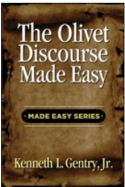
Verse-by-verse analysis of Christ’s teaching on Jerusalem’s destruction in Matt 24. Shows the great tribulation is past, having occurred in AD 70, and is distinct from the Second Advent at the end of history. Provides exegetical reasons for a transition from AD 70 to the Second Advent at Matthew 24:36.
But this issue is not about me. So I must speak to the broader issue regarding whether or not preterism as such is anti-Semitic. My answer to this question should be surmised from all that I have said before: No. Preterism as a theological construct is not anti-Semitic. Let me now respond to the “preterism = anti-Semitism” charge.
Defending by defining
I would point out that we need to define our terms. What is “anti-Semitism”? This term is thrown around a lot, but not often properly interpreted.
First, a basic, sufficient definition is found in Webster’s New Twentieth Century Unabridged Dictionary. There we learn that “anti-Semitism” is: “1. prejudice against Jews; dislike or fear of Jews and Jewish things. 2. discrimination against or persecution of Jews.” This is the only legitimate definition in alleging anti-Semitism. No plank in the preterist system suggests that preterism dislikes Jews, fears them, or wants to discriminate against or persecute them.
The belief that God will not once again exalt Israel above all other nations (as in the OT, e.g., Dt 7:6-8; Psa 147:19-20) is not anti-Semitic. It may be contra-Judaic, but it is not anti-Semitic. That is, preterism certainly contradicts religious Judaism theologically, but it does not seek to persecute ethnic Jews socially.
Second, I would point out another necessary definition in the debate. Preterism teaches that (1) God punished Israel; and he did so (2) in the events of the first century. Preterism holds neither that Christians were ever called upon to persecute Jews (in either the first century or today) nor that God’s judgment wrath is to continue against them today. The prophetically-determined, biblically-defined judgment of God came against them in the concrete, historical, non-repeatable events of the first century in that: this was the generation that rejected Christ, and the temple around which he ministered was the focus of his wrath. Those people of that generation and that institution of that covenant have long since perished.
The Divorce of Israel: A Redemptive-Historical Interpretation of Revelation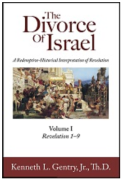
This long-awaited commentary has now been published. It is an 1800 page, two-volume deeply exegetical, academic commentary on the Bible’s most mysterious book.
Click: https://www.kennethgentry.com/the-divorce-of-israel-2-vols-by-gentry-pre-publication-offer/
See more study materials at: www.KennethGentry.com
We need to distinguish between an interpretation of a book written 2000 years ago in the context of great struggle for the life of the church and the ravings of modern racists, zealots, and hotheads. I am interpreting a book regarding events that occurred 20 centuries ago; I am not calling for a continued pogrom against the Jews. In fact, my evangelical Christian theology forbids it (“do unto others as you would have them do unto you”) as well as my postmillennial expectations (“every nation and all tribes and peoples and tongues” will be saved) — as well as the obvious fact that my Savior (“Jesus the Messiah, the son of David, the son of Abraham,” Matt 1:1) and his apostles (Matt 10:1ff) were Jewish.
June 3, 2025
THE APOCALYPSE AND THE OLD TESTAMENT
PMW 2025-042 by Kenneth L. Gentry, Jr.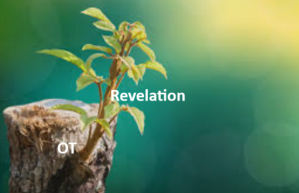
Revelation is a difficult book to interpret. We must read it carefully to detect clues as to John’s meaning. One important issue regarding Revelation’s interpretation regards it extremely Hebraic style. In this brief series I will be highlighting several elements of its Hebraic character.
As a Redemptive-historical Preterist I believe that John is writing about the soon-coming destruction of the Jewish temple in AD 70. When we read Rev we are immediately struck by John’s strongly Jewish presentation. No competent commentator fails to mention this. Fiorenza notes that “it is often judged to be more Jewish than Christian.” Charles argues on the basis of its style that it is obvious that John was a “Palestinian Jew.” Buchanan agrees with J. F. Whealon who “observed that Rev 4:1–22:7 was a Jewish document that was later Christianized by the introduction, conclusion, and a few editorial additions.”
Moyise speaks of “the fact that Revelation can be taken as a profoundly Christian or essentially Jewish” work. Indeed, Bultmann goes so far as to argue that Rev is a “thinly disguised Jewish work.” Marshall even (wrongly) drops the whole idea that Rev is a Christian text by proposing that it is actually a Jewish text urging Asia Minor Jews to quit compromising with secular culture.
BEFORE JERUSALEM FELL
Doctoral dissertation defending a pre-AD 70 date for Revelation’s writing (459 pp; paperback). Thoroughly covers internal evidence from Revelation, external evidence from history, and objections to the early date by scholars.
For more study materials: https://www.kennethgentry.com/
Rev’s intensely Jewish style comports well with a focus on the events associated with the judgment on Israel and the closing of the old covenant order in AD 70. I will be presenting four brief studies demonstrating its Hebrew cast. In this study I will note its:
Old Testament Sources
Beale and Carson point out that “no other book of the NT is as permeated by the OT as is Revelation.” Indeed, “many exegetes have demonstrated that the Apocalypse contains more allusions drawn from the OT writings than any other book in the NT” (Smolarz). Beale states further that “the OT in general plays such a major role that a proper understanding of its use is necessary for an adequate view of the Apocalypse as a whole.” L. Vos declares that John’s “uses of the Old Testament material is without parallel or equal in the New Testament writings.” Prigent adds regarding such required knowledge of the OT: “this prophecy presupposes a well-informed audience.” John assumes his audience’s familiarity with the OT Scriptures.
But why does John so deeply engage the OT? Corsini (403) highlights the importance of John’s OT allusions: It is his “desire to go back, particularly in the face of his Jewish opponents, to the authentic sources of their own revelations.” John does this because he is dealing with the closing of the old covenant economy involving the collapse of the Jewish temple system and the victory of Christianity’s struggle with mother Israel.
Corsini well notes in this regard that “the greatest irony is that John takes the very scriptures of the Jews to show that their worldly hopes, their worldly cult which had become an end in itself was not faithful to their own Book: the story of the Lamb is!” Though unnecessarily limiting his observations to his own special focus, Mathewson admits that “given the role that the Jewish communities played in chs. 2–3, and given the massive recourse to Jewish Scripture in 21.1–22.5, it seems likely that John’s appropriation of Old Testament texts can be accounted for at least partly in light of polemic with Jewish opponents over the interpretation of the Old Testament and the status and identification of the Christian community.”
Matthewson adds further: “One of the functions of John’s allusive appeal to Old Testament texts is to reassert the self-understanding of this readers over against the Jewish community therefore the Christian communities in Asia are the true covenant people of God and recipients of Israel’s promises of restored communion and fellowship.”

Blessed Is He Who Reads: A Primer on the Book of Revelation
By Larry E. Ball
A basic survey of Revelation from an orthodox, evangelical, and Reformed preterist perspective. Ball understands John to be focusing on the destruction of Jerusalem and the temple in AD 70. Insightful. Easy to read.
For more Christian studies see: www.KennethGentry.com
No authoritative source would be more compelling to get John’s point across regarding God’s judgment on Israel than language from Israel’s own Bible drawn especially from her own prophets. No “proof” of God’s coming judgment would be more relevant than the OT. In Rev John is not only making this point dramatically, but he is even framing it in such a way as to reinforce it.
May 30, 2025
SOME ANCIENT PRETERISTS
PMW 2025-042 by Kenneth L. Gentry, Jr.
 Since the 1990s the preterist perspective has been making its presence felt in contemporary prophecy discussions. Unfortunately, dispensational eschatology, which arose in the 1830s and is built on the futurist system, thoroughly dominates evangelical preaching, education, publishing, and broadcasting today. Consequently, evangelical Christians are largely unfamiliar with preterism, making it seem to be the “new kid on the block.” Preterism, however, is as hoary with age as is futurism. And despite its overshadowing in this century, it has been well represented by leading Bible-believing scholars through the centuries into our current day.
Since the 1990s the preterist perspective has been making its presence felt in contemporary prophecy discussions. Unfortunately, dispensational eschatology, which arose in the 1830s and is built on the futurist system, thoroughly dominates evangelical preaching, education, publishing, and broadcasting today. Consequently, evangelical Christians are largely unfamiliar with preterism, making it seem to be the “new kid on the block.” Preterism, however, is as hoary with age as is futurism. And despite its overshadowing in this century, it has been well represented by leading Bible-believing scholars through the centuries into our current day.
In this article I will list a few ancient representatives. Of course, the historicity of the view does not confirm the view — only its biblicity can do that. However, it is always good to be aware of the historical understanding of a doctrinal viewpoint. So let’s get started.
Eusebius
One of the best known and most accessible of the ancient preterists is Eusebius (A.D. 260-340), the “father of church history.” In his classic Ecclesiastical History he details Jerusalem’s woes in A.D. 70. After a lengthy citation from Josephus’s Wars of the Jews, Eusebius writes that “it is fitting to add to his accounts the true prediction of our Saviour in which he foretold these very events” (3:7:1-2.) He then refers to the Olivet Discourse, citing Matthew 24:19-21 as his lead-in reference and later Luke 21:20, 23, 24. He concludes: “If any one compares the words of our Saviour with the other accounts of the historian concerning the whole war, how can one fail to wonder, and to admit that the foreknowledge and the prophecy of our Saviour were truly divine and marvelously strange” (3:7:7).
The Beast of Revelation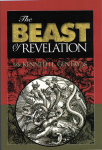
by Ken Gentry
A popularly written antidote to dispensational sensationalism and newspaper exegesis. Convincing biblical and historical evidence showing that the Beast was the Roman Emperor Nero Caesar, the first civil persecutor of the Church. The second half of the book shows Revelation’s date of writing, proving its composition as prior to the Fall of Jerusalem in A.D. 70. A thought-provoking treatment of a fascinating and confusing topic.
For more study materials, go to: KennethGentry.com
The Clements
Another ancient document applying Matthew 24 to A.D. 70 is the Clementine Homilies (2d c.): “Prophesying concerning the temple, He said: ‘See ye these buildings? Verily I say to you, There shall not be left here one stone upon another which shall not be taken away [Matt. 24:3]; and this generation shall not pass until the destruction begin [Matt. 24:34]….’ And in like manner He spoke in plain words the things that were straightway to happen, which we can now see with our eyes, in order that the accomplishment might be among those to whom the word was spoken” (Clem. Hom 3:15).
Clement of Alexandria (A.D. 150-215) discusses Daniel’s seventieth week as a past event: “The half of the week Nero held sway, and in the holy city Jerusalem placed the abomination; and in the half of the week he was taken away, and Otho, and Galba, and Vitellius. And Vespasian rose to the supreme power, and destroyed Jerusalem, and desolated the holy place” (Miscellanies 1:21). The famed premillennialist Tertullian (A.D. 160-225) writes of the Roman conquest: “And thus, in the day of their storming, the Jews fulfilled the seventy hebdomads predicted in Daniel” (An Answer to the Jews, 8).
The Cappadocian Fathers
Even the Book of Revelation is applied to A.D. 70 by many in antiquity. In his Interpretation of the Revelation Andreas of Cappadocia (5th c.) noted that “there are not wanting those who apply this passage to the siege and destruction of Jerusalem by Titus” (Rev. 6:12). Later he commented: “These things are referred by some to those sufferings which were inflicted by the Romans upon the Jews” (Rev. 7:1). According to noted church historian Henry Wace, Andreas’s commentary is “the earliest systematic exposition of the book in the Greek church.” Andreas himself informs us that he wrote it in order “to unfold the meaning of the Apocalypse, and to make the suitable application of its predictions to the times that followed it.”
Arethas of Cappadocia (6th c.) also provides us a commentary on Revelation which, according to Wace “professes to be a compilation” though “no mere reproduction of the work of his predecessor, although it incorporates a large portion of the contents of that work.” Arethas specifically applies various passages in Revelation to A.D. 70 (Rev. 6-7).
Have We Missed the Second Coming: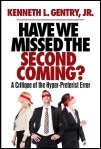
A Critique of the Hyper-preterist Error
by Ken Gentry
This book offers a brief introduction, summary, and critique of Hyper-preterism. Don’t let your church and Christian friends be blindfolded to this new error. To be forewarned is to be forearmed.
For more Christian educational materials: www.KennethGentry.com
May 27, 2025
NOAH AND THE POSTMILLENNIAL HOPE
 In this article I will be looking at the Noahic Covenant. As we might expect, Noah was a postmillennialist. And probably Mrs. Noah (since they seem to have gotten along well in cramped quarters. Her name, by the way, was Joan of Ark).
In this article I will be looking at the Noahic Covenant. As we might expect, Noah was a postmillennialist. And probably Mrs. Noah (since they seem to have gotten along well in cramped quarters. Her name, by the way, was Joan of Ark).
In the Noahic Covenant appear various features which undergird the postmillennial hope of victory in history. We find this particularly in Genesis 6:17–22 and 8:20–9:17. Here God reaffirms the Cultural Mandate, which is fundamental to the outworking of his eschatological purpose through his highest creature, man. Thus, we are witnessing God’s continuing gracious redemptive relation to man as the ongoing basis of the Cultural Mandate. We see this also in the references to the birds, cattle, etc. (cp. Gen 6:20; 8:17 with Gen 1:24, 25), the command to “be fruitful and multiply” (Gen 9:1, 7 with Gen 1:28), and the dominion concept (cf. Gen 9:2 with Gen 1:28). This is necessary to the redemptive-historical character of eschatology.
God establishes this covenant with his people: the family of Noah, which alone escapes the deluge by God’s grace (Heb 11:7; 1 Pet 3:20; 2 Pet 2:5). Thus, this is not solely a common-grace covenant, for God establishes it with his elect people (Noah’s family) and on the basis of sovereign grace and redemptive sacrifice (Ge 6:8; 8:20–22). Furthermore, Scripture unites the Noahic covenant with God’s other redemptive covenants (cf. Hos 2:18 with Gen 6:20; 8:17; 9:9ff). The Cultural Mandate, then, especially relates to the function of God’s people in the world: God expressly reaffirms the Mandate with God’s people, the “you” of Genesis 9:1–12. On the basis of divine covenant God calls his people to the forefront of cultural leadership, with the religious aspects of culture being primary.
In revealing the Noahic covenant we also witness God’s objective relationship with man: God judges the world in history for its sin. God establishes the rainbow as a sign of his covenant mercy with Noah and all that are with him, including their seed (Gen 9:12). This indicates that the world will be protected from God’s curse through the presence of God’s people. God makes the covenant only indirectly with unbelievers, who benefit from God’s protection only as they do not oppose God’s people. Because of God’s love for his people, he preserves the orderly universe (Gen 8:20–22).
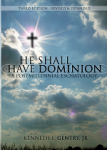
He Shall Have Dominion
(paperback by Kenneth Gentry)
A classic, thorough explanation and defense of postmillennialism (600+ pages). Complete with several chapters answering specific objections.
See more study materials at: www.KennethGentry.com
Thus we see God’s objective corporate sanction against sin in the Flood, which also serves as a type of final judgment (2Pe 3:4–6). We also witness God’s judicial sanctions in history in his ordaining capital punishment (Ge 9:6). God’s objective judgment therefore finds civil expression in man’s affairs. The Lord grants legitimate authority to the civil government to enforce capital punishment. God bases this on a fundamentally religious principle, namely, God’s image in man (Gen 9:6), and gives it to the world through the church (i.e., Noah’s family).
As we trace redemption’s scarlet thread through the fabric of Scriptural revelation and covenant history, the hope of redemptive victory becomes even more clear. A careful study of Scripture demonstrates that history is truly His Story.
Greatness of the Great Commission (by Ken Gentry)
An insightful analysis of the full implications of the great commission as given in Matthew 28:18-20. Impacts postmillennialism as well as the whole Christian worldview.
See more study materials at: www.KennethGentry.com
May 23, 2025
POSTMILLENNIAL RESOURCES
PMW 2025-040 by Thaddeus Majaraj
Gentry note:
Postmillennialism is blessed today to have many resources available and easily accessible through the Internet. This list of books and other resources published by Thaddeus Majaraj is a valuable resource itself!
Postmillennialism: A List of the Best Books and Resources
Here is a list of my top books and resources on Postmillennialism for those who are curious or new to it, learning more about it, or just seeking some more content.
In recent years, there has been a resurgence of the Optimistic Eschatology otherwise known as Postmillennialism. I’ve written elsewhere on the importance of Eschatology to our daily Christian lives. So, for me this is an encouraging trend that I pray continues to bear fruit and grow.
The past few decades in popular Evangelicalism have been largely dominated by (what may be called) Pessimistic views of the End Times—the most popular being Premillennial Dispensationalism. For many, belief in a Rapture, coming Tribulation and the rise of an Antichrist are taken for granted as what every Christian believes about the End Times. Many within Dispensational circles are not even aware that there are other positions (other than variations on where to place the Rapture: Pre-Trib, Mid-Trib, Post-Trib, etc). I know, since I was once part of those circles.
House Divided: The Break-up of Dispensational Theology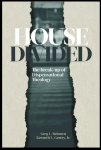 By Greg Bahnsen and Ken Gentry
By Greg Bahnsen and Ken Gentry
This book presents and defends Christian Reconstruction theology, particularly theonomic ethics and postmillennial eschatology. It does to by responding to dispensationalism’s social and exegetical theology.
For more educational materials: www. KennethGentry.com
However, there is a whole world of other more historic eschatological positions which are firmly rooted in a serious desire to properly interpret God’s Word. For this reason, I hope that this brief list of books and resources will help you in your eschatological journey. May the LORD bless and guide you.1
As with all resources, be a good Berean and search the Scriptures for yourself to see if these things are so.
To read full article with whole list, go to: https://www.theotivity.com/post/best-books-resources-postmillennialism/
May 20, 2025
POSTMILLENNIALISM FOR DUMMIES
PMW 2025-039 by Uri Brito
Gentry note:
This posting was written by my friend, Uri Brito, about three years ago. I would like to promote its wider reading, especially to my PostmillennialWorldview readers. It is an excellent, brief presentation of the importance of serious postmillennialism.
Postmillennialism for Dummies
One of the joys of speaking loudly around here is that I get to see some fine china broken in real-time. That’s a metaphor for views being shattered and replaced by something else, for those of you just tuning in.
The thing broken is a variation of pessimistic eschatology and it is being replaced with some happy, hopeful, and hosannah postmillennialism. Mind you, I am not so much concerned about the loyalty to the systematic category, but to the heart of the matter. Because es-cha-to-lo-gy has consequences for casuistry. Say that three times.
It pleases me to see folks going through that radical transformation and sending me notes about it. Just this last week, two brothers texted me separated by 30 minutes sharing with me their newfound dogmatism for stout-beer postmillennialism. And the good news is that they didn’t come into it half-heartedly. They did the hard work of research, reading, and repeating. It is an amazing thing to plant seeds for a long time, only to see them bear fruit much later. God seems to work like that on many occasions. I believe we are reaching a stage of massive theological conversions, and I have alluded to some of these factors before, but the postmil conversion is a fruitful blossoming of many seeds planted long ago.
The Truth about Postmillennialism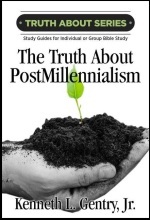 By Ken Gentry
By Ken Gentry
A group Bible study guide for explaining the optimistic prophetic hope for this world to be accomplished before Christ’s Second Coming. Establishes the postmillennial system in both the Old and New Testaments. Touches on key eschatological issues, such as creation, covenant, interpretive methodolgy, the great tribulation, the Book of Revelation, the Jewish Temple, and more. It presents and answers the leading objections to postmillennialism.Twelve chapters are ideal for one quarter of Sunday School.
See more study materials at: www.KennethGentry.com
I have been harping on the postmil “C” chord for a really long time and I think postmil eschatology is beginning to see a resurgence. This may be the result of ecclesiastical behaviors these past two years. In fact, I will go so far as to say that the churches who have been pushing against shut-downs and sundry silliness have postmil bones. Now, lots of other non-postmil flocks have come alongside our efforts, or later decided to peek behind the curtain, but the reality is that the majority of pastors I know who decided to fight the tide named one of their kids or their dogs, B.B. Warfield.
The reason this happens is not that dispensationalists are gnostic pirates, but because theology and ideas matter. A theology that urges the Christian population to shut down or cave in cannot be a theology that says “Jesus shall reign where’r the sun doth his successive journeys run!” It simply can’t!
Now, yes, there are peoples of all eschatological stripes who act inconsistently with their theologies and opine like disciples of John Murray, but by and large, attitudes of reconciliation with government officials who were eager to steal your liberty didn’t come from postmil reformers. They came from those who believed and affirmed a spiritualized kingdom only; one who was content with the chorus, “If the ship is sinking, why polish the brass!”
Postmillennial eschatology is a direct sport eschatology. It’s not flag football, it’s the result of a baby created by rugby and Constantinian religion. It’s real. It’s fleshly. It’s in your face. And wherever it goes, it carries three main affirmations:
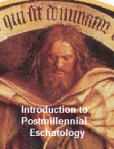
Introduction to Postmillennial Eschatology (10 downloadable mp3 lectures)
by Ken Gentry
Lecture presentations and some classroom interaction. Very helpful definition, presentation, and defense of postmillennialism.
See more study materials at: www.KennethGentry.com
First, it affirms that the Christian faith is rooted in the proto-evangelium (Gen. 3:15). It believes that the first Gospel preached was a Gospel that de-throned disciples of the Serpent and moved forward on the offense against religious and political tyrants (II Cor. 10:5). The seed of the woman shall crush the head of the serpent in tangible ways, which necessitates the confrontation of institutions and systems that do not harmonize with the kingdom of heaven.
Second, it affirms the centrality of the Cultural and Great Commissions (Gen. 1:26-28; Matt. 28:18-20). Postmil is not an eschatology of guesses, it’s an eschatology of certainty. We don’t walk around wondering whether the kingdom will come on earth as it is in heaven, we affirm the kingdom shall come on earth as it is in heaven in history and time. Christ shall return to receive a glorified bride, not a defeated bride. The great feast is a glorious feast of victorious proclamations (Rev. 7:12). What God commands shall be fulfilled, and there are no nuances to that.
Finally, it affirms a bodily sacrificial life before the watching world (Rom. 12:1-2). The certainty of postmil eschatology is not naive about suffering and pain. In fact, it triumphs through our suffering and pain. It sees the sacrifice of the Church as a sacrifice towards something; a symphonic movement reaching its finale. Postmil doesn’t tolerate mandates because it keeps us from forming a Christ-shaped society in our churches and homes and cultures. It moves through sacrificial acts of worship first on the first day of the week (Acts 20:7) and then throughout the rest of time (I Cor. 10:31).
Postmillennialism breaks the fine china of …
Note:
To finish reading, go to: https://kuyperian.com/postmillennialism-for-dummies/
May 16, 2025
STAND FIRM IN THE RESURRECTION HOPE (6)
 PMW 2025-038 by Kenneth L. Gentry, Jr.
PMW 2025-038 by Kenneth L. Gentry, Jr.
I am concluding a series on the resurrection body as found in 1 Corinthians 15. I am arguing for the position of historic Christianity that the resurrection body is a qualitatively transformed physical body rather than an altogether new spiritual body, as per Gnosticism.
The “problem” we face
In this article I will focus on 1 Cor. 15:44, which is an important verse that can easily mislead the incautious reader. This verse states of the physical body that dies and is resurrected that:
“it is sown a natural body, it is raised a spiritual body. If there is a natural body, there is also a spiritual body.”
Obviously the phrase “spiritual body” (soma pneumatikon) is the source of confusion. But this statement does not speak of the substance of the resurrected body. Paul no more states that it is composed of spirit, than the statement “this is a Coca-Cola bottle” speaks of a bottle composed of Coca-Cola. As James Ware puts it, here “Paul refers not to a body composed of material spirit but to the risen body of flesh and bones given life by the Spirit of God.” This is a common-place interpretation, especially in Reformed theology (e.g., Geehardus Vos, Richard Gaffin, etc.).
THE APOCALYPSE OF JOHN
by Milton S. Terry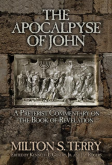
This book is Terry’s preterist commentary on the Book of Revelation. It was originally the last half of his much larger work, Biblical Apocalyptics. It is deeply-exegetical, tightly-argued, and clearly-presented.
For more study materials: https://www.kennethgentry.com/
(As an aside, when I first entered seminary at Grace Theological Seminary in 1973, I was a dispensationalist. But I became discouraged with dispensationalism and transferred to Reformed Theological Seminary to study theology from a Reformed perspective. There I was introduced to biblical theology and the whole idea of covenantalism. One eye-opening course was on biblical theology taught by Dr. Gerard Van Groningen. The professor not only taught from but required us to read Geerhardus Vos’ Biblical Theology: Old and New Testaments, which offered me remarkable insights into the Scriptures. But transferring out of a dispensational seminary into a Reformed seminary caused me to have to go to seminary for four years instead of the usual three years, because of the different courses required at RTS. However, I profited theologically from my move. And I did learn about 1 Cor. 15:44 from a classically Reformed perspective, which was helpful. But now, back to work.)
But how are we to understand this verse? It seems so clear. How could historic, orthodox Christianity have developed a doctrine of the physical resurrection of the body as a key component of the essence of its faith with this verse staring it in the face for 2000 years? Especially after Paul declares anyone contradicting his view of the resurrection is a “fool” (1 Cor. 15:36)!
The “spiritual body” explained
In the first place we must recognize that Paul does not speak of a “fleshly” body and a “spiritual” body. Had that been his point he would have called the unresurrected body a sarkinos (from sarx, “flesh”) body. But “flesh” and “spirit” are not being contrasted here. We can see this in the unusual fact that he compares a “soulish” (psuchikos from psuche, “soul”) with the “spiritual” (pneumatikos) body. The psuchikos body is clearly not a body made up of soul material in contrast to a pneumatikos body made up of spirit material. Such would be absurd. And Gnostically-oriented hyper-preterism is absurd.
Reformed Eschatology in the Writings of Geerhardus Vos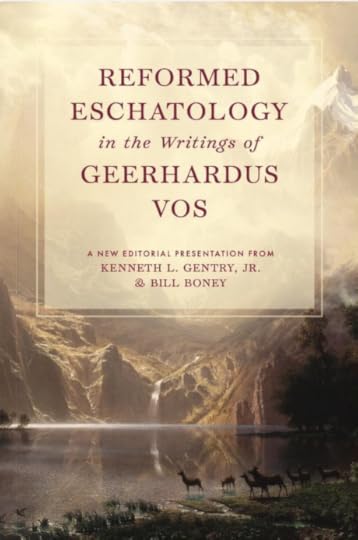
Ed. by Ken Gentry and Bill Boney
This is a collection of several key eschatological studies by the renowned Reformed theologian Geehardus Vos. We have modernized Vos’ grammar and syntax and updated his layout style according to modern publishing conventions (shorter sentences and paragraphs). We did this without changing any of Vos’ arguments.
For more information on this new Vos work or to order it, see:
https://www.kennethgentry.com/reformed-eschatology-in-the-writings-of-geerhardus-vos/
What Paul is describing here by “natural body” is a body activated or driven by the human soul. Otherwise this would demand that Paul sees our current bodies as made up purely of soul! This, then, would not be a body such as we live in now, a body of “flesh and blood” (as per v. 50).
Rather, the “soulish/natural body” and the “spiritual body” refer to the body’s source of its life and direction. A soulish body is a body controlled by natural life and its animal appetites and needs. Whereas a spiritual body is a body raised and driven by the Spirit of God. The “spiritual” body is the “Spirit-raised” and therefore “Spirit-driven” body.
In the second place, Paul has already anticipated this understanding earlier in this very epistle. For in 1 Cor. 2:14–15 Paul contrasts the psuchikos anthropos (translated “natural man”) with the pneumatikos man:
“But a natural man [psuchikos anthropos] does not accept the things of the Spirit of God, for they are foolishness to him; and he cannot understand them, because they are spiritually appraised. But he who is spiritual [pneumatikos] appraises all things, yet he himself is appraised by no one.
Here Paul is surely not declaring that some men are made of “spirit” (pneuma) and are to be preferred over those who are made out of “soul” (psuchikos)! Both of these persons are simply flesh-and-blood individuals, one is led by the Spirit and the other has no concern for the things of the Spirit. That which makes the two different is just this important fact: one is led by the Spirit of God (to pneuma tou theou) (2:11), the “Spirit who is from God” (to pneuma to ek tou theou) (2:12). But the other is not.
Tongues-speaking: Meaning, Purpose, and Cessation
 by Ken Gentry
by Ken Gentry
The position presented within is that tongues-speaking allowed the gift person to speak in a known human language without previously knowing it; tongues brought inspired revelation from God; the gift was a sign confirming the apostolic witness and warning of the coming destruction of Jerusalem; and therefore the gift ceased in the first century.
See more study materials at: www.KennethGentry.com
In fact, nowhere in Paul’s writings does the adjective pneumatikos mean “made of spirit” (cp. 1 Cor. 2:15: 3:1; 10:3–4;14:37). It always speaks of the activity of the Holy Spirit being somehow involved. Consequently, the “spiritual body” (15:44) is the resurrected body activated by the Spirit of God.
In the third place, the soma pneumatikon speaks of the body resurrected by the Spirit, i.e., given the fullness of eternal life by God’s Spirit. The Holy Spirit is often spoken of by Paul as the primary agent of the resurrection, both of believers and of Christ himself (Rom. 8:9–11, 23; 2 Cor. 5:4–5; Gal. 5:25; 6:7–8). In fact, this is the direct link between the believer and Christ, for: “if the Spirit of Him who raised Jesus from the dead dwells in you, He who raised Christ Jesus from the dead will also give life to your mortal bodies through His Spirit who dwells in you” (Rom. 8:11).
Conclusion
In his conclusion to his insightful article on 1 Corinthians 15:36–54, Ware writes (in part):
“In conclusion regarding the soma pneumatikon of 15:44: the syntax of the passage, the lexical evidence of Paul’s key terms in their wider ancient context, Paul’s usage elsewhere in the letter, and the larger context of Paul’s own thought each preclude the notion that the adjectives. psuchikos and pneumatikos in this passage refer to the body’s composition. Rather, the term soma psuchikon describes the present body as given life by the soul, the life given by the very breath of God (1 Cor. 15:45a, egeneto ho protos anthropos Adam eis psuchen zosan, ‘the first man, Adam, became a soul that is living’ [echoing Gen 2:7]), but in Adam subject to mortality and decay (l Cor 15:21–22). In the same way, the term soma pneumatikos describes the resurrected body as given life by the Spirit of God, the life given by Christ, the new Adam (1 Cor 15:45b … ‘the last Adam became a Spirit that is life-giving’), and thus bestowing on the body a mode of existence that is immortal and imperishable (l Cor. 5:20–26, 42–43, 46–49, 52–54). The soma pneumatikon in Paul’s thought is not a body composed of ethereal pneuma but the body of flesh and bones endowed with imperishable life by the power of the Spirit.”
GOODBIRTH AND THE TWO AGES
I am currently researching a technical study on the concept of the Two Ages in Scripture. This study is not only important for understanding the proper biblical concept of the structure of redemptive history. But it is also absolutely essential for fully grasping the significance of the Disciples’ questions in Matthew 24:3, which spark the Olivet Discourse. This book will be the forerunner to a fuller commentary on the Olivet Discourse in Matthew’s comprehensive presentation. This issue must be dealt with before one can seriously delve into the Discourse itself.
If you would like to support me in my research, I invite you to consider giving a tax-deductible contribution to my research and writing ministry: GoodBirth Ministries. Your help is much appreciated! https://www.paypal.com/donate/?cmd=_s-xclick&hosted_button_id=4XXFLGKEQU48C&ssrt=1740411591428
May 13, 2025
STAND FIRM IN THE RESURRECTION HOPE (5)
PMW 2025-037 by Kenneth L. Gentry, Jr.
Introduction
I am now presenting my fifth in a series of studies on the nature of the resurrection body as found in 1 Corinthians 15. I am declaring, along with historic Christianity, that our physical bodies die in history but that those very bodies arise at the end of history in the resurrection of the dead. This is far from the proto-Gnostic views of ancient heretics, modern liberals, and contemporary hyper-preterists, including Paul’s opponents at Corinth.[1]
So, now let us move on to reflect on:
The language of “change” in Paul’s argument
Having briefly considered the rhetorical structure of Paul’s argument in 1 Corinthians 15:36–54, we should now note how Paul speaks of the resurrection body in terms of “change” (allasso). After charging his opponents with being “fools” (v. 36) regarding their resurrection-body error, he answers their foolishness in the immediately following verses. Then in verses 51–52 he speaks of the “change” which defines the resurrection:
“Behold, I tell you a mystery; we will not all sleep, but we will all be changed, in a moment, in the twinkling of an eye, at the last trumpet; for the trumpet will sound, and the dead will be raised imperishable, and we will be changed.”
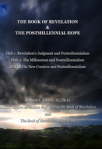 The Book of Revelation and Postmillennialism (Lectures by Ken Gentry)
The Book of Revelation and Postmillennialism (Lectures by Ken Gentry)
In the first of these three 50-minute lectures Gentry explains Revelation’s judgments to show they do not contradict postmillennialism. In the next two lectures he shows how the Millennium and the New Creation themes strongly support the gospel victory hope found in postmillennialism.
See more study materials at: www.KennethGentry.com
As noted in previous articles, Paul chooses his resurrection language carefully in emphasizing the nature of the resurrection body. Thus here he employs the word allasso (“change”) in referring to the result of the resurrection. This word demands continuity through a transition (the body is resurrected) over against destruction or replacement (the body is replaced with a new and different body), as per Gnostic expectations. The body that dies does not cease to exist, it is not annihilated, it is not dissipated; it is the deceased body that is transformed by becoming — more glorious. That is, the very body that died changes by becoming imperishable (rather than remaining perishable) and immortal (rather than remaining mortal) (vv. 53–54). Ware points out that this involves “continuity accompanied by change.”
Resurrection does not involve a new body coming into existence which never previously existed. Rather, it involves a qualitative change (a getting better) rather than a substantive (a substitution) change. The physical body is not replaced with a ethereal body.
The Divorce of Israel: A Redemptive-Historical Interpretation of Revelation
This long-awaited commentary has now been published. It is an 1800 page, two-volume deeply exegetical, academic commentary on the Bible’s most mysterious book.
Click: https://www.kennethgentry.com/the-divorce-of-israel-2-vols-by-gentry-pre-publication-offer/
See more study materials at: www.KennethGentry.com
The structural emphasis revisited
As has been argued in preceding articles in this series, the structure of Paul’s argument in vv. 36–54 is important. It fits well with the concept of transformation of the body over against the destruction and replacement of the body.
We need to recall the verbal pairs in Paul’s presentation, noticing that the subject of Paul’s discussion remains the same: the body in which we live in time and on earth. The contrasts he presents are not matters of the substance of the body but of the qualities brought about in the body. That is, Paul speaks of a change off qualities or conditions: from perishable to imperishable (v. 42), from dishonor to glory (v. 43a), from weakness to power (v. 43b). But it is the physical body of our human existence that dies and enjoys these qualitative changes, these marvelous enhancements. As Ware expresses it: “Paul’s series of oppositions does not describe two different bodies, distinct in substance, but two contrasting modes of existence of the same body, one prior to and the other subsequent to the resurrection.”
And we must remember that Paul’s structuring of his argument (note v. 42 as set over against vv. 53–54) emphasizes the transformational character of the resurrected body. It does so by drawing out the specific, essential contrasts between the resurrected and the non-resurrected bodies: perishable/imperishable (v. 42) introduces the section, while perishable/imperishable concludes the section (vv. 53–54). The material body is not destroyed and done away with. Rather that very body itself is transformed by new and glorious qualities.
I will continue on this important theme in my next posting. There I will take up the issue of the pneumatikon body (v. 44). It is not what the untrained eye suspects!
Notes
1. I am building on the meticulous exegetical argument of James Ware from the University of Evansville, Indiana: “Paul’s Understanding of the Resurrection in 1 Corinthians 15:36–54,” Journal of Biblical Literature 133:4 (2014): 809–35. I highly recommend also his powerful, sizeable (413 pages!) commentary on 1 Corinthians 15, a must read for serious evangelical Christians who are concerned by defections from the historic Christian faith on eschatology and soteriology: The Final Triumph of God: Jesus, the Eyewitnesses, and the Resurrection of the Body in 1 Corinthians 15 (Grand Rapids: Eerdmans, 2025).
Kenneth L. Gentry Jr.'s Blog
- Kenneth L. Gentry Jr.'s profile
- 85 followers



